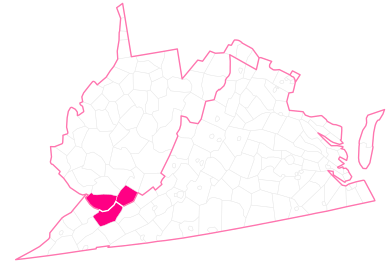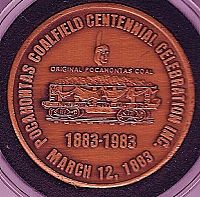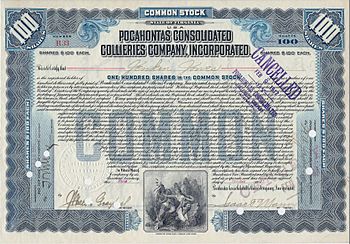Pocahontas Coalfield facts for kids
The Pocahontas Coalfield, also called the Flat Top-Pocahontas Coalfield, is a special area where a lot of coal was found. It stretches across Mercer County and McDowell County in West Virginia, and Tazewell County in Virginia.
People started mining coal here in 1883 in a town called Pocahontas, Virginia. The first mine was Pocahontas Mine No. 1. Today, this old mine is a special historical site.
The coal found in this area, especially from seams like Pocahontas No. 3, No. 4, No. 6, and No. 11, is known as some of the best in the world. It's very high quality, meaning it produces a lot of heat when burned.
Early mining operations here included special ovens called beehive coke ovens. These ovens turned coal into coke, which is used to make steel. Over time, these operations grew into a big company called the Pocahontas Fuel Company. This company ran mines in places like Boissevain and Amonate in Virginia, and Jenkinjones, Bishop, and Itmann in West Virginia.
How the Pocahontas Coalfield Grew
Later, the Pocahontas Fuel Company became part of a larger company called Consolidation Coal Company. This company still mines coal in some areas today, like Amonate.
The mines in Pocahontas could start shipping their coal when the Norfolk & Western Railway bought another railroad and built a new line to the area. As this railroad expanded west through Mercer and McDowell Counties, more and more coal mines opened up. By the mid-1880s, the area around Bramwell was booming with mines in towns like Coopers and Freeman.
More coal mines kept opening in the 1890s. The Norfolk & Western Railroad continued to lay tracks, reaching towns like Welch. Some of the new mining towns and camps included Maybeury, Elkhorn, Upland, and Keystone.
Why Pocahontas Coal Was Important
The coal from the Pocahontas Coalfield became very famous for its quality. By 1903, a huge company called U.S. Steel started its own mining company, U.S. Coal and Coke, to get coal from central McDowell County. Their main operations were around Gary. Many smaller mining towns, or "coal town suburbs," grew up around Gary. For example, Wilcoe was Gary No. 1, Ream was Gary No. 6, and Elbert was Gary No. 8.
At first, the coal was turned into coke right at the mine sites using beehive ovens. This coke was then sent to steel mills. After 1918, the coal was shipped by train to a very large coke plant in Clairton. The U.S. Steel mines in the Gary area did very well until the 1980s, when they closed down. This led to a difficult time for Gary.
The Pocahontas Coalfield continued to be very active through both World War I and World War II. After the 1930s, the United Mine Workers union became strong in the area, helping miners. Many African-Americans moved to the coalfield from the South, looking for better opportunities. Even today, McDowell County has a high percentage of African-American residents compared to other counties in West Virginia. People also came from countries like Poland, Hungary, Italy, and Greece, making the coal camps very diverse.
In the middle of the 20th century, mines were busy in places like Capels, Caretta, Coalwood, and Berwind. Sadly, there were also accidents. On January 10, 1940, an explosion at the Bartley No. 1 Mine killed 91 miners. Later, on January 15, 1956, the Havaco No. 9 mine explosion took the lives of 15 coal miners.
Mining of this special coal continued strongly through the energy boom of the late 1970s and early 1980s. However, since 1990, the coalfield has seen a decline. Many people have moved away, and the population has dropped a lot. For example, McDowell County had about 100,000 people in 1950, but only about 22,000 in 2010. Even so, a few medium and small mines are still working today.
Coal Camp Towns
Many towns grew up around the coal mines in the Pocahontas Coalfield. These were often called "coal camps" or "coal towns." Here are some of their names:




